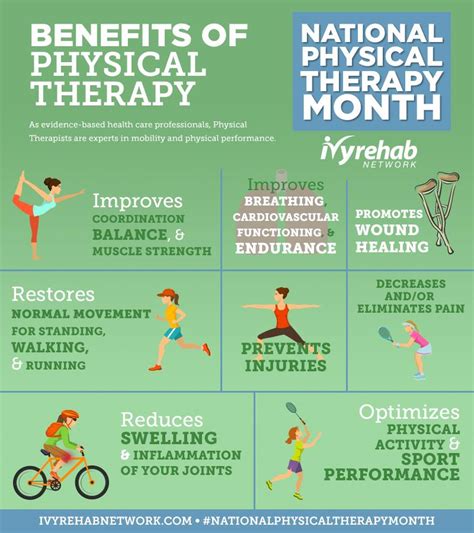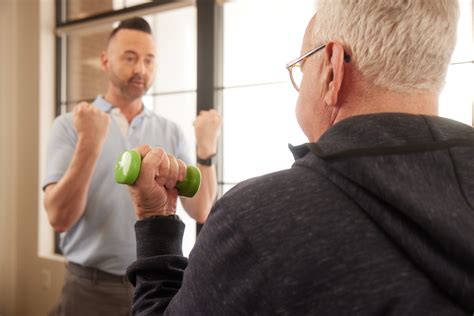Intro
Discover the transformative power of physical therapy in improving your overall health. Learn how PT can increase mobility, reduce chronic pain, enhance athletic performance, and boost mental well-being. Explore the top 5 ways physical therapy can help you recover, rehabilitate, and thrive, from injury prevention to chronic condition management.
Physical therapy is a vital aspect of healthcare that plays a significant role in improving overall health and well-being. While many people associate physical therapy with rehabilitation after an injury or surgery, its benefits extend far beyond that. In this article, we will explore the five ways physical therapy improves your health and why it should be an integral part of your healthcare routine.

1. Reduces Pain and Inflammation
Chronic pain and inflammation are common health issues that affect millions of people worldwide. Physical therapy is a non-invasive and non-pharmacological approach to managing pain and inflammation. Through various techniques such as manual therapy, exercise, and modalities like heat, cold, and electrical stimulation, physical therapists can help reduce pain and inflammation, improving overall function and mobility.
For example, a study published in the Journal of Orthopaedic and Sports Physical Therapy found that physical therapy significantly reduced pain and improved function in patients with knee osteoarthritis. The study concluded that physical therapy is a safe and effective treatment option for managing knee osteoarthritis.
How Physical Therapy Reduces Pain and Inflammation
- Manual therapy: Physical therapists use various manual techniques such as massage, joint mobilization, and soft tissue mobilization to reduce pain and inflammation.
- Exercise: Gentle exercises like yoga, Pilates, and stretching can help reduce pain and inflammation by promoting relaxation and reducing muscle tension.
- Modalities: Heat, cold, and electrical stimulation can help reduce pain and inflammation by increasing blood flow and reducing muscle spasms.

2. Improves Mobility and Function
Physical therapy plays a crucial role in improving mobility and function, especially in individuals with chronic conditions or injuries. Through a combination of exercises, manual therapy, and modalities, physical therapists can help improve range of motion, strength, and flexibility, enabling individuals to perform daily activities with ease.
For instance, a study published in the Journal of Geriatric Physical Therapy found that physical therapy significantly improved mobility and function in older adults with hip fractures. The study concluded that physical therapy is an essential component of rehabilitation after hip fractures.
How Physical Therapy Improves Mobility and Function
- Exercise: Gentle exercises like walking, swimming, and cycling can help improve mobility and function by promoting cardiovascular health and strengthening muscles.
- Manual therapy: Physical therapists use manual techniques like joint mobilization and soft tissue mobilization to improve range of motion and reduce stiffness.
- Modalities: Electrical stimulation and heat therapy can help improve muscle strength and function.

3. Enhances Balance and Coordination
Balance and coordination are essential for daily activities, and physical therapy can help improve these skills. Through various exercises and techniques, physical therapists can help individuals develop better balance and coordination, reducing the risk of falls and injuries.
For example, a study published in the Journal of Neurologic Physical Therapy found that physical therapy significantly improved balance and coordination in individuals with Parkinson's disease. The study concluded that physical therapy is a safe and effective treatment option for managing Parkinson's disease.
How Physical Therapy Enhances Balance and Coordination
- Exercise: Exercises like tai chi, yoga, and balance training can help improve balance and coordination by promoting relaxation and reducing muscle tension.
- Manual therapy: Physical therapists use manual techniques like joint mobilization and soft tissue mobilization to improve proprioception and reduce stiffness.
- Modalities: Electrical stimulation and heat therapy can help improve muscle strength and function.

4. Supports Weight Management
Physical therapy can play a significant role in weight management by promoting healthy lifestyle habits and providing personalized exercise programs. Through a combination of exercises, education, and support, physical therapists can help individuals achieve and maintain a healthy weight.
For instance, a study published in the Journal of Obesity found that physical therapy significantly improved weight loss and weight maintenance in individuals with obesity. The study concluded that physical therapy is an essential component of weight management programs.
How Physical Therapy Supports Weight Management
- Exercise: Gentle exercises like walking, swimming, and cycling can help improve cardiovascular health and promote weight loss.
- Education: Physical therapists provide education on healthy lifestyle habits, including nutrition and stress management.
- Support: Physical therapists offer ongoing support and motivation to help individuals achieve and maintain a healthy weight.

5. Reduces Stress and Anxiety
Physical therapy can help reduce stress and anxiety by promoting relaxation and reducing muscle tension. Through various techniques such as manual therapy, exercise, and modalities, physical therapists can help individuals manage stress and anxiety, improving overall mental health and well-being.
For example, a study published in the Journal of Clinical Psychology found that physical therapy significantly reduced stress and anxiety in individuals with chronic pain. The study concluded that physical therapy is a safe and effective treatment option for managing chronic pain and stress.
How Physical Therapy Reduces Stress and Anxiety
- Manual therapy: Physical therapists use manual techniques like massage and joint mobilization to reduce muscle tension and promote relaxation.
- Exercise: Gentle exercises like yoga, Pilates, and stretching can help reduce stress and anxiety by promoting relaxation and reducing muscle tension.
- Modalities: Heat, cold, and electrical stimulation can help reduce stress and anxiety by promoting relaxation and reducing muscle spasms.

In conclusion, physical therapy is a vital aspect of healthcare that improves overall health and well-being. From reducing pain and inflammation to supporting weight management, physical therapy offers numerous benefits that can enhance quality of life. If you're considering physical therapy, don't hesitate to consult with a physical therapist to develop a personalized program that meets your unique needs and goals.
What is physical therapy?
+Physical therapy is a healthcare profession that helps individuals develop, maintain, and restore maximum movement and functional ability throughout their lives.
What are the benefits of physical therapy?
+Physical therapy offers numerous benefits, including reduced pain and inflammation, improved mobility and function, enhanced balance and coordination, supported weight management, and reduced stress and anxiety.
How can I find a physical therapist?
+You can find a physical therapist by asking your primary care physician for a referral, searching online, or contacting your local physical therapy association for a list of licensed physical therapists in your area.
